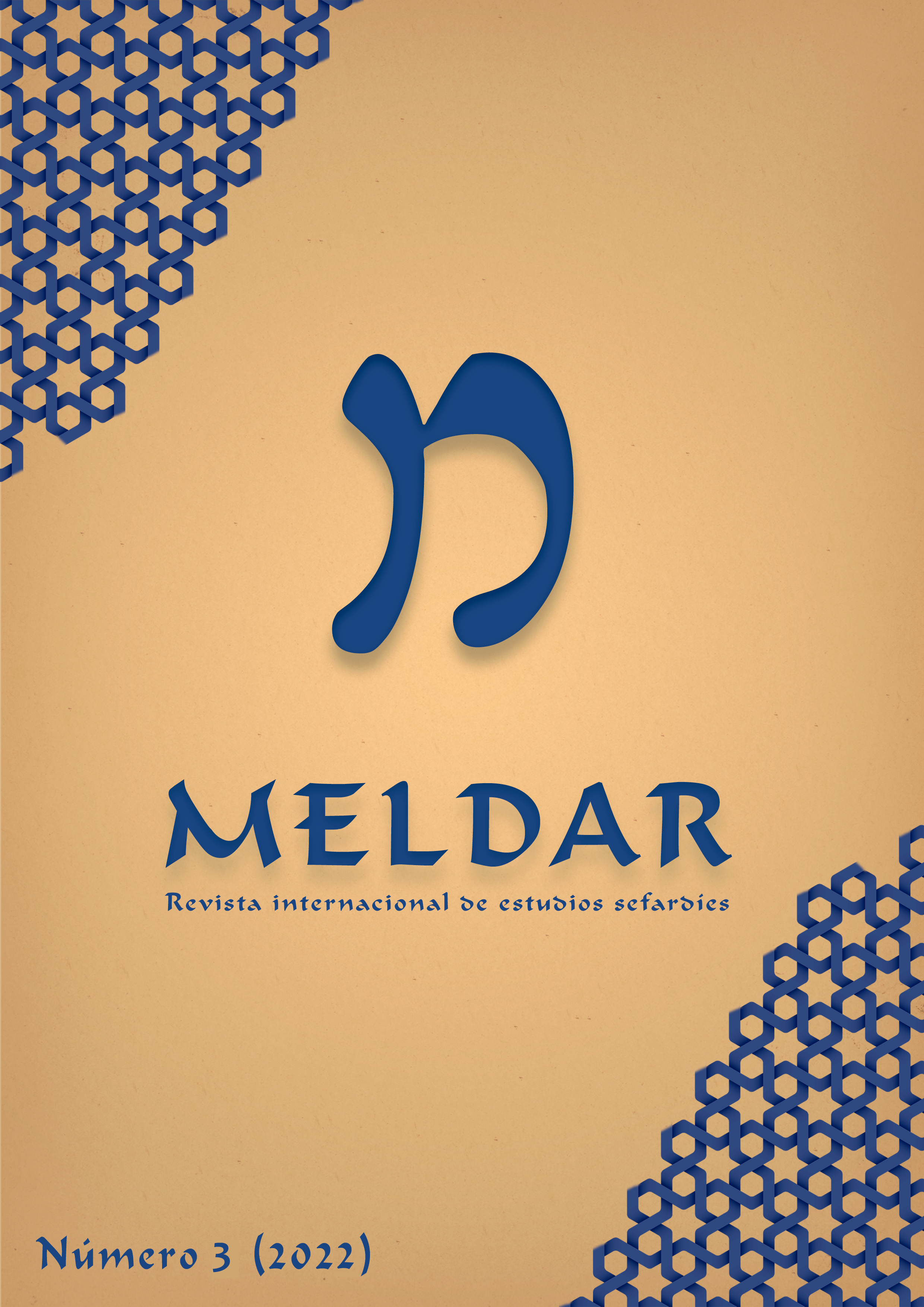El gueto de Varsovia en la poesía sobre el tema del Holocausto de Ester Morguez Algrante
DOI:
https://doi.org/10.46661/meldar.7415Palabras clave:
judeoespañol, poesía, Holocausto, gueto de VarsoviaResumen
Ester Morguez Algrante (Esmirna, 1916-1984) fue una poeta de Turquía que, sin ser una damnificada directa ni una descendiente de sobrevivientes del Holocausto, dedicó parte de sus poemas a la memoria de las víctimas de su pueblo. El gueto de Varsovia, un lugar emblemático que representa el sufrimiento y el heroísmo de los judíos durante la Segunda Guerra Mundial, se testimonia en cada uno de esos 12 poemas. Este estudio tendrá como objetivo reflexionar y analizar el mundo poético de Ester Morguez Algrante en lo referente a su poesía sobre el tema del Holocausto.
Descargas
Citas
Asseo, David. (1975). Felicitaciones del Gran Rabino a Mme. Morguez. Şalom, 1432 (23/4/1975), 1.
August-Zarębska, Agnieszka. (2012). Testimonios poéticos del aniquilamiento de la comunidad sefardí de Salónica. Itinerarios, 15, 141-158. Recuperado de https://dialnet.unirioja.es/servlet/articulo?codigo=5912919
Ben Haim, Zerubavel. (1945). Hantze and Frumka: Lettres and souvenirs. Ein Harod: Hakibutz Hameuhad [en hebreo].
Benbanaste, Nesim. (1988). Örneklerle Türk Musevi Basininim Tarihçesi. Istanbul: N. Benbanaste.
Bokser Misses-Liwerant, Judit. (2017). Holocausto, Modernidad, memoria.... Nuevas reflexiones críticas en torno a Bauman. Revista Mexicana de Ciencias Políticas y Sociales, 62 (230), 339-358. https://doi.org/10.1016/S0185-1918(17)30028-4
Brodsky, Patricio. (s. f.). Memoria de la Shoá en la Identidad Nacional Israeli. Recuperado de https://www.academia.edu/33161503/Memoria_de_la_Shoa_en_la_Identidad_Nacional_Israeli
Burns, Margie. (2005). Turquía fue un refugio para los judíos durante el Holocausto. The International Raoul Wallenberg Foundation. Recuperado de https://www.raoulwallenberg.net/es/salvadores/diplomat/turquia-fue-refugio-judios/
Eidherr, Armin. (2000). Los kaminos s’incheron de arena: Antolojia de la poezia sefardi kontemporanea. Viena: Am Herezen Europas 5 [en judeoespañol, alemán y turco].
Elmaleh, Abraham. (1965). Esther Morguez Algranti: escritora digna de admiración. El Tiempo, 779-780, 2.
Gaon, Moshe David. (1965). A bibliography of the Judeo-Spanish Press. Jerusalem: Ben Zvi Institute [en hebreo].
Grosman, Moshe (1975). Mme. Morguez in Kitabi. Şalom, 1431 (16/4/1975), 3.
Grosman, Moshe. (1992). Dr. Marcus (1870-1944), Osmanlidan Cunhuriyete Gechishte Turk Yahudilerinden Gürünümler. Istanbul: Dünden, Bugünden, Yarina.
Gruss, Susy. (2013). Ester Morguez Algrante – la voz femenina de Izmir. Journal of Sephardic Studies, I, 104-121. Recuperado de http://sefarad-studies.org/Contents.html
Gruss, Susy. (2014). Biva, biva la Reyna Esther Morguez con toda la Djoudería. Ladinar: Estudios sobre la literatura, la música y la historia de los sefardíes, VII-VIII, 113-133.
Gruss, Susy. (2016a). Esther Morguez Algrante, una mujer de tinta y letra. En Rifat Bali (ed.), Jewish Journalism and Press in the Ottoman Empire and Turkey (pp. 389-406). Istanbul: Libra.
Gruss, Susy. (2016b). La poetisa Esther Morguez Algrante de Esmirna y su poemario 9 Eylül”. En Paloma Díaz-Mas y Elisa Martín Ortega (eds.), Mujeres sefardíes lectoras y escritoras, siglos XIX-XX (pp. 207-222). Madrid – Frankfurt am Main: Iberoamericana – Vervuert. https://doi.org/10.31819/9783954878864-010
Gruss, Susy. (2018). Los poemas inéditos de Yehudá Haim Perahiá sobre el tema del Holocausto. Cuadernos de Estudios Sefardíes, 18, 11-59.
Hilberg, Raúl. (2005). La destrucción de los judíos europeos. Madrid: Akal.
León, Abraham. (1975). Biografía de Esther Morguez Algranti. En 9 Eylül. Estambul: Baykar.
Lévy, Isaac Jack (1989). And the World Stood Silent. Sephardic Poetry of the Holocaust. Urbana-Chicago: University of Illinois Press.
Lévy, Isaac Jack y Lévy Zumwalt, Rosemary. (2020). The Sephardim in the Holocaust: A Forgotten People, Tuscaloosa: The University of Alabama Press.
Martín Ortega, Elisa. (2014). Para una nómina de poetisas sefardíes posteriores al Holocausto. eHumanista 28, 790-812. Recuperado de https://www.ehumanista.ucsb.edu/volumes/28
Morguez Algrante, Ester. (1954). Un dokumento akresante. A la seryoza atansion de las komunidades de Turkia. La Vera Luz, 208/97, 3.
Morguez Algrante, Ester. (1958). Souhaitos de saloud al Signor Juda Haim Perahia de Xanthie. La Vera Luz, 252, 2.
Morguez Algrante, Ester. (1971). Treblinka. Şalom, 1226 (21/4/1971), 4.
Morguez Algrante, Ester. (1975). 9 Eylül. Estambul: Baykar.
Nagar-Ron, Sigal (2006). La Historia Tal Como Mi Abuela Me Contó. La Memoria Personal Frente A La Memoria Colectiva Sionista. Acta Poética, 27(2), 197-217. https://doi.org/10.19130/iifl.ap.2006.2.211
Neustadt, Melekh. (1946). The Destruction and Resistance of the Jews of Warsaw. Tel Aviv: Vaad hapoel shel Hahistadut haklalit [en hebreo].
Neyzi, Leyla y Bofill, Mireia. (2000). Recordar que hay que Olvidar: Sabetianismo, identidad nacional y subjetividad en Turquía. Historia, Antropología y Fuentes Orales, 24, 5-29.
Oppenheimer, Yochai. (2010). The Holocaust: A Mizrahi Perspective. Hebrew Studies, 51, 281-306.
Perelis, Rivkah. (1987). Pioneering Youth Movements in Occupied Poland. Tel Aviv: Hakibbutz Hameuhad.
Refael, Shmuel. (1988). Roots of Hell: Greek Jewry in the Holocaust: Testimonies. Tel Aviv: Hamahon ke heker Yahadut Saloniki, Irgun Nitzole Mahanot Hahashmada [en hebreo].
Refael, Shmuel. (1994). Contemporary Judeo-Spanish (Ladino) Holocaust poetry. En Lóránt Kabdebó, Erzsébet Schmidt (eds), A Holocaust a muvészetekben = The Holocaust in the Arts (pp. 96-99). Pécs: Janus Pannonius Egyetemi Kiadó.
Refael, Shmuel. (2008). Un grito en el silencio. La poesía sobre el Holocausto en lengua sefardí: Estudio y antología. Barcelona: Tirocinio.
Rodrigue, Aron. (2005). Sephardim and the Holocaust. Washington: United States Holocaust Memorial Museum, Center for Advanced Holocaust Studies. Recuperado de https://collections.ushmm.org/search/catalog/bib104730
Romero, Elena. (1992). La creación literaria en lengua sefardí. Madrid: MAPFRE.
Shimoni, Batia. (2011). Hasimán hakahol hafah lihiyot ka´akúa shel mispar: al kinat Shoah basifrut hamizrahit. Dapim leheker haShoah, 191-216 [en hebreo].
Shimshi, Naomi. (1994). Frumka Plotniczki. En Avihu Ronen and Yehoyakim Kokhavi (eds.), Guf Shelishi Yahid. Tel Aviv: Kibbutz Lohamei ha-Getta’ot [en hebreo].
Steiner, Jean François (1967). Treblinka. Barcelona: Círculo de lectores.
Ventura, Avram. (2010). Diyalog. Publicación digital de los judíos turkanos de Izmir, (marzo, 2010), 122 131.
Yablonka, Hanna. (2008). Off the Beaten Track: The Mizrahim and the Shoah. Tel Aviv: Yedioth Aharonoth, Books and Chemed Books [en hebreo].
Yablonka, Hanna (2001). The State of Israel vs. Adolf Eichman. Jerusalén: Yad Ben Zvi [en hebreo].
Descargas
Publicado
Cómo citar
Número
Sección
Licencia
Derechos de autor 2022 Meldar: Revista internacional de estudios sefardíes

Esta obra está bajo una licencia internacional Creative Commons Atribución-NoComercial 4.0.
Las obras se publican en la edición electrónica de la revista bajo una licencia Creative Commons Reconocimiento-NoComercial-4.0 Internacional: se pueden copiar, usar, difundir, transmitir y exponer públicamente, siempre que:
- Se cite la autoría y la fuente original de su publicación (revista, editorial y URL de la obra).
- No se usen para fines comerciales.
- Se mencione la existencia y especificaciones de esta licencia de uso.




 @meldar__
@meldar__


